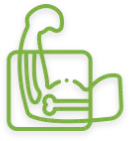
WHAT IS DEXA?
Short for dual-energy absorptiometry, A DEXA scan analyzes body composition. This provides a more accurate portrait of your soft tissue and bone composition. By breaking down your scan in quantifiable muscle mass, fat, and bone density, DEXA allows you to better assess your risks for many things, including osteoporosis and fat-related diseases.
Soft Tissue
It can be hard to interpret what you’re seeing on the scale. Muscle weighs more than bone. So are the extra pounds you’re seeing a result of your new workout regimen, or are you still dealing with body fat?
The old-school measures such as Body Mass Index (BMI) and calipers are ineffective. Some people carry their body fat deep within their bodies, while others attain sufficient muscle mass to throw off their weight charts. So what are you working with?
Bone Density
It can be hard to know how healthy our bones are, since we can’t see them. As most people know, we lose bone mass as we age, leading to osteoporosis. Certain medications and dietary choices can also contribute to bone loss, makes fractures much more likely.
Despite being a common aliment, osteoporosis can be hard to diagnose. Unfortunately, many people don’t realize they’ve developed osteoporosis until they’ve already sustained a fracture. The only way to know for sure is to do a bone density scan — and the simplest, most insightful way is to use DEXA!
Why Choose DEXA?
Soft Tissue
InBody, BodPod, and hydrostatic weighing are all effective tools for scanning. However, DEXA has something that the others don’t. It can differentiate between lean fat (the protective cells that insulate your body) and visceral fat (the type of fat associated with chronic disease and mortality risk).
The simple fact is, the weight alone means nothing. Many physicians rely solely on BMI and other limited measures to assess their patients’ health. A change on the scale can be due to changes in muscle mass, fat tissue, or even the amount of water your body is holding
Bone Density
What about X-rays, CT scans, and MRIs? These methods are best for identifying fractures and injuries, but lack the ability to provide information on your bone density and strength. DEXA not only does this, but can also identify over-porous tissue throughout your body, especially in high-risk areas such as your hips, wrists, and spine.
Most patients don’t realize the importance of getting bone-density scans until they’ve already experienced a fracture. As with any age-related condition, osteoporosis is easier to treat when
diagnosed early.
At Well Life Family Medicine, we aim to discover your true body composition and better assess your health, so we can recommend an effective plan that will allow you to get a better grip on your overall health and wellness goals!

Mapping Your Health with DEXA
Soft Tissue
Do you work out frequently? Are you “heavy boned?” Your BMI could be wildly inaccurate. Your doctor may diagnose you as “overweight” when you’re not. The margin of error is up to 15 percent! This can also cause your doctor to neglect to identify high-risk visceral fat in skinnier patients. In fact, visceral adipose tissue is the leading factor in cardiovascular disease and may not be reflected in one’s body shape or scale reading.
If you’re building muscle or recovering from an injury, DEXA allows you to assess your muscle growth and symmetry.
This gives you a better look at how your overall body composition is supporting your goals and if you’re developing the right areas.

Bone Density
DEXA compiles your bone density profile by measuring the number of X-rays that your bones absorb and converts these findings into two metrics: your T-score and Z-score.
1. T-score- the amount of bone tissue you have compared to younger individuals.
Estimates your likelihood of fracture.
Doctors may recommend preventative bone- restoration treatments to minimize your risk.
2. Z score- compares your bone density to that of others in your age group.
Doctors use this to decide whether other tests are necessary to diagnose osteoporosis.
Next Steps
At Well Life Family Medicine, we use DEXA to evaluate your body’s bone and core tissues to gain greater insights into the next steps of your health journey.

Nutrition
The food and supplements you consume can make or break your health. Work with our nutritionists to design a diet specifically designed for you.

Fitness Sessions
Like muscle, bone is living tissue that responds to exercise by becoming stronger. Work with our personal trainer to develop an exercise regimen to improve your bone density and overall
health.

Whole Body Vibration
Studies have found that Whole Body Vibration increases bone density. Hop on our machine at the office to increase your bone strength.

Comprehensive Labs
Labs can help us determine if there is an underlying condition affecting your bone density. With that knowledge, we can get to the root of your issues.
At Well Life Family Medicine, we aim to discover your true body composition and better assess your health, so we can recommend an effective plan that will allow you to get a better grip on your overall health and wellness goals!
Copyright 2023 by Well Life Family Medical